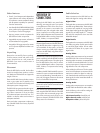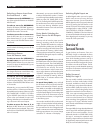
21
English
MULTI Inputs
A set of RCA inputs accept up to 7.1 chan-
nels of analog signals from a DVD-A or
SACD player. There are inputs for FRONT L
& R, CENTER, SUB, REAR L & R, and CEN
-
TER BACK 1 & 2.
These inputs bypass all digital processing in
the RSP-1069 and are routed directly to the
Volume control and preamp outputs.
There are two subwoofer options for the MULTI
input. Normally, the .1 channel input is passed
through directly to the subwoofer output. An
optional bass redirect feature duplicates the
7 main channels, sums them, and sends this
mono signal through a 100 Hz analog low
filter to the subwoofer output. This provides
an unaltered analog bypass for the seven
main channels along with a subwoofer sig
-
nal derived from those channels.
Preamp Outputs
A group of ten RCA analog audio outputs
sends the RSP-1069’s line level output signals to
external amplifiers and powered subwoofers.
These outputs are variable level, adjusted by
the RSP-1069 volume control. The eight connec
-
tors provide output for: FRONT L & R, CENTER
1 & 2, SURROUND L & R, CENTER BACK CB1
& CB2, and SUBWOOFER 1 & 2.
NOTE: Depending on your system configura-
tion, you may use some or all of these con
-
nections. For example, if you only have one
center channel, connect it to the CENTER 1
output. If you only have one center back chan
-
nel, connect it to the CB1 output.
ZONE 2–4 Audio Outputs
Three pair of RCA jacks, labeled ZONE OUT
send analog audio signals to audio systems
in up to three remote zones. These outputs
can be configured as either fixed or variable
level using the ZONE SETUP menu.
NOTE: Only analog input signals are available
at the Zone 2, 3, and 4 outputs. Source com
-
ponents connected to only the digital inputs
are not available in the remote zones.
To configure your system for remote zone op
-
eration, connect the left and right Zone 2 , 3,
or 4 outputs on the RSP-1069 to the left and
right channel inputs of the amplifier power
-
ing the remote zone speakers, using standard
RCA audio cables. There are also composite
video outputs for each of the zones.
Other Connections
AC Input
Your RSP-1069 is configured at the factory
for the proper AC line voltage in the coun
-
try where you purchased it (USA: 120 volts/
60Hz AC or CE: 230 volts/50 Hz AC ). The
AC line configuration is noted on a decal on
the back of your unit.
Plug the supplied cord into the AC INPUT re
-
ceptacle on the back of the unit.
NOTE: Memorized settings and video labels
are preserved indefinitely, even if the RSP-1069
is disconnected from AC power.
Master Power Switch
The large rocker switch on the rear panel is
a master power switch. When it is in the OFF
position, power to the unit is completely off.
When it is in the ON position, the front panel
STANDBY and remote control ON/OFF but
-
tons can be used to activate the unit or put it
into standby mode.
NOTE: After all connections are completed,
the rear panel master power switch should
be put in the ON position and usually left in
that position.
12V TRIGGER Connections
Many Rotel amplifiers offer the option of turn-
ing them on and off using a 12 volt trigger.
These six connections provide this 12 volt
trigger signal from the RSP-1069. When the
RSP-1069 is activated, a 12 volt DC signal
is sent from these jacks to the amplifiers to
turn them on. When the RSP-1069 is put in
STANDBY mode, the trigger signal is inter
-
rupted and the amplifiers turn off.
To use the remote turn on feature, connect
one of the RSP-1069’s 12V TRIG OUT jacks to
the 12 volt trigger input of a Rotel amplifier,
using a cable with mono 3.5 mm mini-plugs
on both ends. The +12 V DC signal appears
at the “tip” connector.
NOTE: The 12V Trigger outputs are configured
to turn on in various combinations only when
specific input sources are activated. See the
INPUT SETUP and ZONE 2–4 SETUP menus in
the Setup section of this manual for details.
REM IN Jacks
Four 3.5 mm mini-jacks (labeled EXT, ZONE
2, ZONE 3, and ZONE 4) receive command
codes from a third-party infrared receiver or
Rotel remote zone keypad, These remote IR
inputs are used when the IR signals from a
hand held remote control cannot reach the
front panel IR sensor.
EXT: The EXT jack is used with an outboard
IR receiver to duplicate the front panel IR
sensor. This feature is useful when the unit
is installed in a cabinet and the front panel
sensor is blocked or when IR signals need to
be relayed to other components.
ZONE: The ZONE 2, 3, or 4 jacks are used
with IR repeater systems to receive signals
from IR control systems in remote locations.
For example, remote control signals sent to
the ZONE 2 jack control the ZONE 2 fea
-
tures of the RSP-1069 and can be relayed to
other components.
Consult your authorized Rotel dealer for
information on external receivers and the
proper wiring of a 3.5 mm mini-plugs to fit
the REM IN jacks.
NOTE: The IR signals from the EXT IN and
ZONE IN jacks can be relayed to source
components using external IR emitters or
hard-wired connections from the IR OUT
jacks. See the following section for additional
information.
IR OUT Jacks
The IR OUT 1 & 2 jacks send IR signals received
at the REM IN ZONE 2–4 jacks or the REM
IN EXT jack to an infrared blaster or emitter
placed in front of a source component’s IR
sensor. In addition, the IR OUT can be hard-
wired to Rotel CD players, DVD players, or
tuners with a compatible connector.
These outputs are used to allow IR signals
from the three remote zones to be sent to the
source components, or to pass along IR sig
-
nals from a remote in the main room when
the sensors on the source components are
blocked by installation in a cabinet.
See your authorized Rotel dealer for informa
-
tion on IR emitters and repeater systems.


















